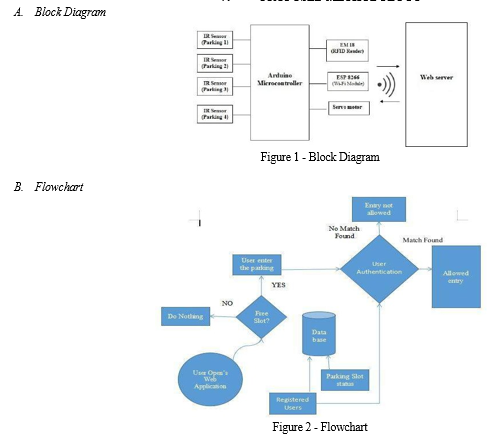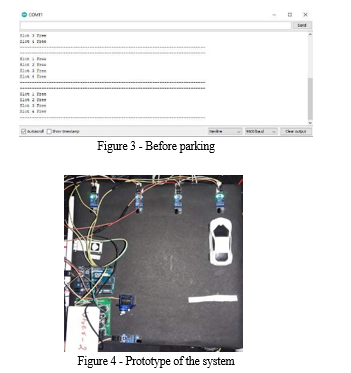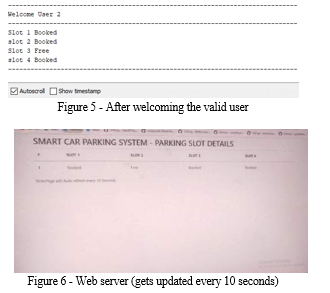Ijraset Journal For Research in Applied Science and Engineering Technology
- Home / Ijraset
- On This Page
- Abstract
- Introduction
- Conclusion
- References
- Copyright
Enhanced Framework for Secure Smart Parking Management
Authors: K F Azmath Ulla, Madhu Kumar K, Mohamed Rizwan, Muzammil Pasha, Mrs. Prathibha Kiran
DOI Link: https://doi.org/10.22214/ijraset.2022.45255
Certificate: View Certificate
Abstract
Due to parking system mismanagement, a simple and uncomplicated task such as parking is perceived as a tiresome and time-consuming operation. The Internet of Things (IoT) is able to connect billions of devices and services at any time in any place, with various applications. The Internet of Things (IoT) connects surrounding environmental objects to the internet, allowing them to be accessed from any remote place. Smart parking systems typically gather data on available parking slots in a certain geographic region and process it in real time to allow vehicles to park in those spaces. The majority of existing smart parking systems jeopardize drivers\' privacy by disclosing data about their visited locations. They also suffer from a lack of transparency, since the centralized service organizer may favor some parking lots over others by booking their spaces first. To tackle these concerns, we propose an enhanced, secure, blockchain-based smart parking management. The goal of this project is to design, analyses, and implement a \"secure smart parking management\" keeping the privacy intact. This is done with the help of RFID card, in which the necessary details of the vehicle is stored. This system is implemented using low-cost IR sensors, Arduino UNO, RFID system and a web application is developed.
Introduction
I. INTRODUCTION
Locating a parking spot during peak hours in most populated areas like shopping malls, universities, exhibitions or convention centers is difficult for the drivers. The difficulty rises from not knowing where the available spots may be at that required time. Smart parking is a solution to metropolitan cities to reduce congestion, cut vehicle emission totals and save persons’ time by helping them in finding a spot to park. Smart Parking is a parking system, usually a new one that is equipped with special structured devices (things) to detect the available parking slots at any parking area. This is an application based on Internet of Things (IoT) that in Real-Time environment have sensors and devices embedded into parking spaces, transmitting data on the occupancy status; and the vehicle drivers can search for parking availability using their mobile phones or any infotainment system that is attached to the vehicle. Hence the driver would know where there is an available spot to park his vehicle in less time, reducing the energy consumption and air pollution.
The Client or the sensor posts the parking slot occupancy status to a web service URL. In this paper, we are suggesting the technique to design and build Smart parking system typically to obtain information about available parking spaces and process it in real-time to facilitate vehicle parking at available positions.
Various parking systems have been done in the past. It is apparent that the car parking systems implemented in developed countries are done with advanced technologies deployed in the car park. This section reviews various works conducted on smart car parking systems. Some available car parking systems researches are sensor based which generally processed the problem of locating an unoccupied car parking place. Similarly the same aspects were observed which may lead to a higher traffic congestion while other parking recourses remain available to use. Moreover, the problem with these systems are that they are unable to find out a solution available and the roads traffic congestions. Hence, the main focus was in determining the occupancy status of parking spaces. Some of the researches focused on information system and guidance for parking.
Those systems provide users information via some message signs in actual time available parking spaces for a specific zone. The total occupancy is gathered by using the sensors on the both entrance and exit of the parking location. Moreover, in result of the survey shows that there is a huge desire from the participants for more dynamic, accurate and personalised parking information at both before the trip and en-route.
In recent research in metropolitan cities the parking management problem can be viewed from several angles. High vehicle density on roads. This results in annoying issue for the drivers to park their vehicles as it is very difficult to find a parking slot. The drivers usually waste time and effort in finding parking space and end up parking their vehicles finding a space on streets. In worst case, people fail to find any parking space especially during peak hours and festive seasons. A Smart Parking System like this helps drivers make smart decisions which will reduce congestion and make the most of available spaces. Finding a parking space has become a daily concern these days, and that is where the motivation for this project came up from. With the evolution of technology, we have smartphones, sensors that detect the presence of any object and my idea is having a system where parking spaces are equipped with these IR sensors that tells about the occupancy status of the parking spaces and a central management system that posts this occupancy status to a web application to guide the drivers in finding a vacant slot.
II. LITERATURE SURVEY
- Smart Parking System with Privacy Preservation and Reputation Management Using Blockchain, Author: Mahmoud M. Badr, Wesam Al Amiri, Mostafa M. Fouda, Abdulah Jeza Aljohani, And Mohamed M. E. A. Mahmoud And Waleed Alasmary year: 2020 Most of the existing smart parking systems threaten the drivers’ privacy by revealing information about their visited locations. Moreover, they are centralized making them vulnerable to a single point of failure and attack, which threatens the availability of the parking service. They also suffer from a lack of transparency, where the centralized service organizer may favor some parking lots by booking their parking slots first. To tackle these concerns, we propose a blockchain-based smart parking system with privacy preservation and reputation management. In our system, a consortium blockchain is created by different parking lots to run the parking system securely and transparently, where the parking offers are recorded on a shared and immutable ledger.
- Parking IoT Technologies: About Smart Parking Systems, Author: Digiteum Team, and Year: 2019 Due to the increase in car ownership, it’s getting harder to find parking spots in densely populated areas. Searching for an available lot takes up potentially productive time, increases the number of cars circulating the roads, and introduces new challenges to the infrastructure. To help city residents drive around and park comfortably, assistive technology like IoT in facility management (https://www.digiteum.com/iot-facility- management/) is actively brought to the industry. In this post, you will find out how IoT is used to reduce parking-related road accidents, shorten the search time, and increase the level of drivers’ comfort.
- Smart Car Parking System Solution for the Internet of Things in Smart Cities, Author: Wael Alsafery, Badraddin Alturki, Kamal M. Jambi and Stephan Reiff-Marganiec, Year: 2018 The Internet of Things (IoT) is able to connect billions of devices and services at any time in any place, with various applications. Recently, the IoT became an emerging technology. One of the most significant current research discussion topics on the IoT is about the smart car parking. A modern urban city has over a million of cars on its roads but it does not have enough parking space.
- Smart Parking System using IoT Technology, Author Prof. Denis Ashok, Akshat Tiwari, 2’, Ning Wang!, and Zhijun Li, Year: 2020 A simple and easy task such as parking is thought as a tedious and time-consuming process due to mismanagement of parking system. Current parking systems involve huge manpower for management and requires user to search for parking space floor by floor. Such conventional systems utilize more power, along with user’s valuable time.
III. OBJECTIVE
- The main aim of this project is to reduce the risk of finding the parking slots in any parking area and keeping the user information safe.
- It eliminates the unnecessary travelling of vehicles across the filled parking slots in a city.
- It keeps the private information of the user secure using blockchain.
- These devices can communicate directly with a parking server.
- Hence, it can provide real-time parking availability information using an online platform to drivers.
IV. HARDWARE DESCRIPTION
- ARDUINO UNO: Arduino Uno is a microcontroller board based on 8-bit ATmega328P microcontroller. Along with ATmega328P, it consists other components such as crystal oscillator, serial communication, voltage regulator, etc. to support the microcontroller. Arduino Uno has 14 digital input/output pins (out of which 6 can be used as PWM outputs), 6 analog input pins, a USB connection, A Power barrel jack, an ICSP header and a reset button.
- ESP8266 NODE MCU: The NodeMCU ESP8266 development board comes with the ESP-12E module containing ESP8266 chip having Tensilica Xtensa 32-bit LX106 RISC microprocessor. This microprocessor supports RTOS and operates at 80MHz to 160 MHz adjustable clock frequency. NodeMCU has 128 KB RAM and 4MB of Flash memory to store data and programs. Its high processing power with in-built Wi-Fi / Bluetooth and Deep Sleep Operating features make it ideal for IoT projects.
- Servo Motor: A servo motor is a type of motor that can rotate with great precision. Normally this type of motor consists of a control circuit that provides feedback on the current position of the motor shaft, this feedback allows the servo motors to rotate with great precision. If you want to rotate an object at some specific angles or distance, then you use a servo motor.
- EM18 RFID Reader: Radio frequency Identification (RFID) is a wireless identification technology that uses radio waves to identify the presence of RFID tags. Just like Bar code reader, RFID technology is used for identification of people, object etc. presence.
- IR Sensor: An infrared sensor is an electronic device that emits in order to sense some aspects of the surroundings. An IR sensor can measure the heat of an object as well as detects the motion. These types of sensors measure only infrared radiation, rather than emitting it that is called a passive IR sensor. Usually, in the infrared spectrum, all the objects radiate some form of thermal radiation.
- 9V Battery: A nine-volt battery, either disposable or rechargeable, is usually used in smoke alarms, smoke detectors, walkie-talkies, transistor radios, test and instrumentation devices, medical batteries, LCD displays, and other small portable appliances
V. PROPOSED METHODOLOGY

Smart Parking System is a web application that is developed to help drivers in finding a vacant parking space during any time of day. The main objective of the application is to provide the occupancy status (vacant/occupied) of the parking spaces.
The main feature of the application is:
Parking Slot Occupancy: This is the part of the application where there is a dashboard that has occupancy statuses of the parking slots. The dashboard is refreshed every 10 sec and the latest information is displayed for the user.
This smart parking system project consists of Arduino, five IR sensors, one servo motor, NodeMCU, EM-18 RFID Module and one LCD display where the Arduino is the microcontroller that controls the whole system. One IR sensor is used at the entry gate to detect vehicle entry in the parking area and other four IR sensors are used to detect the parking slot availability and send the data to NodeMCU. The servo motor is placed at the entry that is used to open the gate. So whenever the IR sensor detects a car, the RFID reader scans the RFID card for the tag number of the vehicle, if the tag number is found in the local database then the servo motor automatically rotates from 0° to 90°, and after a delay, it will return to its initial position. Also, an LCD display is placed at the entrance, which is used to show the availability of parking slots in the parking area.
When a vehicle arrives at the gate of the parking area, the display and the web application continuously shows the number of empty slots. If there are any empty slots then the system opens the entry gate by the servo motor. After entering the car into the parking area, when it occupies a slot, then the display and the web application shows this slot is full. If there is no empty parking slot then the system displays all slots are full and does not open the gate.
NodeMCU sends the parking availability to web server so that it can be monitored by a user from anywhere. The user receives an update about the availability of all parking spots in the website and when the user reaches the parking lot the user can choose any of the available parking spots.
The main idea was the creation of smart parking using the Internet of Things and Blockchain, where available parking places could be displayed in a web application and the user data is encrypted in blocks using blockchain. It provides confidentiality of the user data. This data is stored in a secured manner.
This system also uses RFID based digital parking management system. RFID (Radio Frequency Identification) is used for the authentication of the user at the entry point. Without the human intervention entry point will handle very fast thus avoiding the traffic jam during the process.
VI. EXPERIMENTAL RESULT


VII. FUTURE SCOPE
This application is an initial step in reaching the effective solution for the daily concern. This project can be extended in multiple ways:
- To provide a central management system that make sure only authenticated information is sent to the Client, i.e. dealing with the security issues.
- More analysis can be done using the parking history data by which User can get recommendations or suggestions on parking spaces and their availability trends.
- And this analysis can be used while reserving a parking space by User or while renting a space, to decide the price of the parking space.
- We could also do a mobile application through which driver can get the occupancy statuses of the parking spaces.
Conclusion
Smart Parking System is a solution to the existing traffic congestion, to reduce drivers’ frustration by providing information about the occupancy status of the parking spaces. The project development went smoothly while teaching me many best practices in programming using the current trending technologies. I could see that all the initial requirements of the project are achieved and also I tried doing minor data analysis on the parking spaces occupancy statuses. The web application is user friendly; any user can easily find the status (vacant/occupied) of the parking space and also can set the required date to see the parking history. Starting from coming up with project idea, understanding the requirements and choosing the best technologies for the implementation, all this gave me very good experience and exposure in development of a full stack web application. Upon completing this project successfully, I got familiar with Arduino, MySQL, and Xampp. The concepts of Smart Cities have always been a dream for humanity. Since the past couple of years large advancements have been made in making smart cities a reality. The growth of Internet of Things and Cloud technologies have given rise to new possibilities in terms of smart cities. Smart parking facilities and traffic management systems have always been at the core of constructing smart cities. In this paper, we address the issue of parking and present an IoT based Cloud integrated smart parking system. The system that we propose provides real time information regarding availability of parking slots in a parking area. Users from remote locations could book a parking slot for them by the use of our mobile application. The efforts made in this paper are indented to improve the parking facilities of a city and thereby aiming to enhance the quality of life of its people.
References
[1] Rico, J., Sancho, J., Cendon, B., & Camus, M. (2013, March). Parking Easier By Using Context Information of a Smart City: Enabling Fast Search and Management of Parking Resources. In Advanced Information Networking and Applications Workshops (Waina), 2013 27th International Conference on (Pp. 1380-1385). IEEE. [2] Zheng, Y., Rajasegarar, S., & Leckie, C. (2015, April). Parking Availability Prediction for Sensor-Enabled Car Parks in Smart Cities. In Intelligent Sensors, Sensor Networks and Information Processing (Is snip), 2015 Ieee Tenth International Conference On (Pp. 1-6). IEEE. [3] Zhou, F., & Li, Q. (2014, November). Parking Guidance System Based On Zigbee And Geomagnetic Sensor Technology. In Distributed Computing and Applications to Business, Engineering and Science (Dcabes), 2014 13th International Symposium on (Pp. 268-271). IEEE. [4] Botta, A., De Donato, W., Persico, V., & Pescapé, A. (2014, August). On The Integration of Cloud Computing and Internet of Things. In Future Internet of Things and Cloud (Ficloud), 2014 International Conference on (Pp. 23-30). IEEE. [5] Ji, Z., Ganchev, I., O\'droma, M., & Zhang, X. (2014, August). A Cloudbased Intelligent Car Parking Services for Smart Cities. In General Assembly and Scientific Symposium (Ursi Gass), 2014 Xxxith Ursi (Pp. 1-4). IEEE. [6] International Parking Institute, “2012 Emerging Trends in [7] Parking”. [8] Ballon, P., Glidden, J., Kranas, P., Menychtas, A., Ruston, S., & Van Der Graaf, S. (2011, October). Is There A Need For A Cloud Platform For European Smart Cities? In Echallenges E-2011 Conference Proceedings, Iimc International Information Management Corporation. [9] Fastpark System Website, Http://Www.Fastprk.Com.
Copyright
Copyright © 2022 K F Azmath Ulla, Madhu Kumar K, Mohamed Rizwan, Muzammil Pasha, Mrs. Prathibha Kiran. This is an open access article distributed under the Creative Commons Attribution License, which permits unrestricted use, distribution, and reproduction in any medium, provided the original work is properly cited.

Download Paper
Paper Id : IJRASET45255
Publish Date : 2022-07-02
ISSN : 2321-9653
Publisher Name : IJRASET
DOI Link : Click Here
 Submit Paper Online
Submit Paper Online

